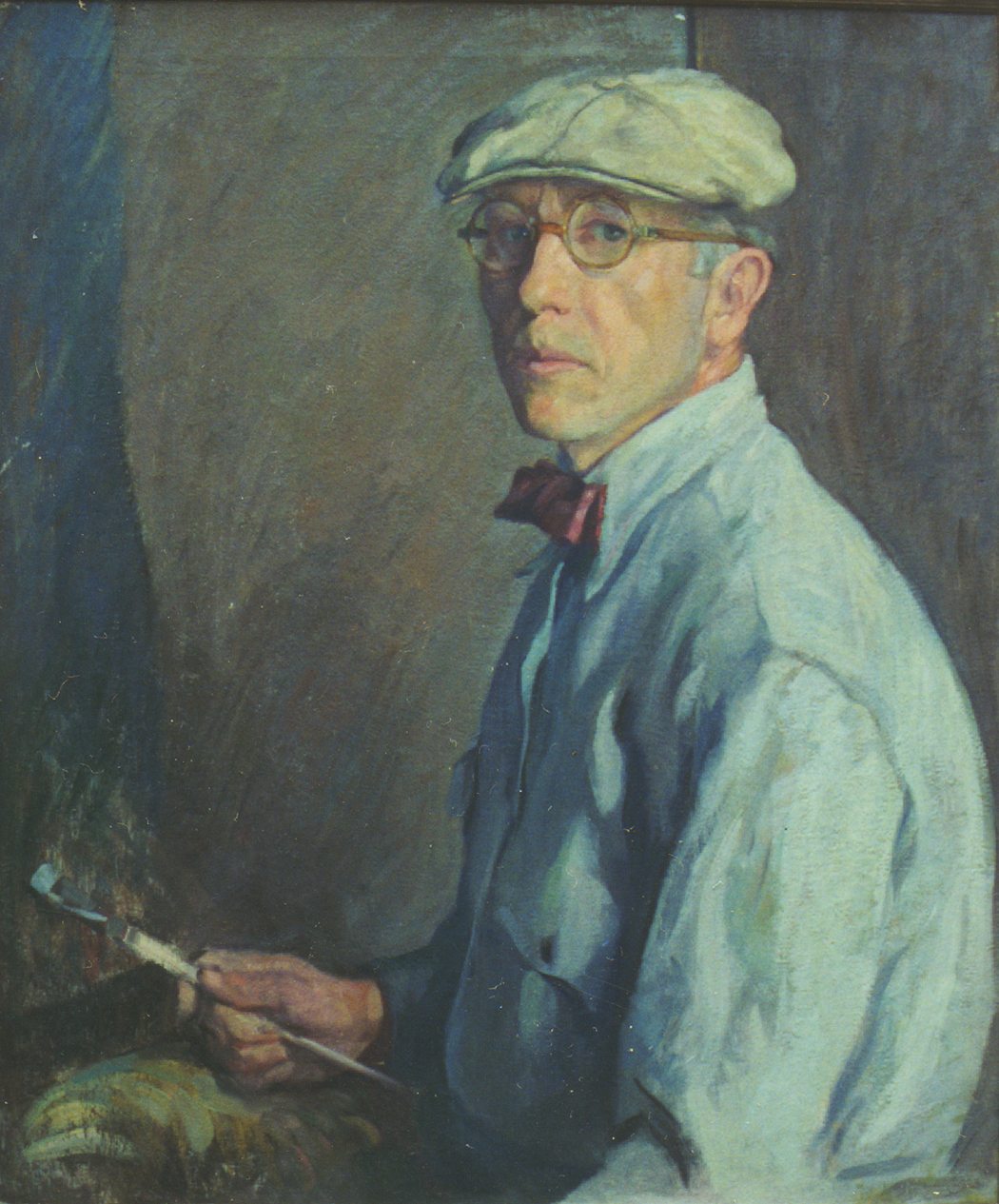Biography of Roy Cleveland Nuse (1885-1975)
Self Portrait with Brush
Roy C. Nuse was a Pennsylvania Impressionist artist and a respected teacher at the Pennsylvania Academy of Fine Arts in Philadelphia, Pennsylvania from 1925 to 1954. He lived and painted in Bucks County, Pennsylvania for almost 60 years, working in a plein-air, impressionist style. He had six children that were often the subjects of some of his best paintings, especially those in outdoor, rural, farm settings. He painted landscapes, figures in the landscape, still lifes and portraits. He worked primarily in oils, but also enjoyed using pastels.
A native of Springfield, Ohio, Roy helped out in his father’s barbershop until his father became ill and Roy had to drop out of high school. He took a factory job hand-painting lamp shades, where he was recognized for his talent and encouraged to go to art school. He enrolled at the Cincinnati Art Academy in 1905 and remained there until 1912, studying under Vincent Nowottny and Frank Duveneck. In 1915, he obtained a part-time teaching job at the Beechwood School near Philadelphia, which enabled him to attend the Pennsylvania Academy of Fine Arts, which was then one of the most renowned art schools in the nation.
A student at the Pennsylvania Academy of Fine Arts from 1915-1918, Nuse’s talents were recognized and he won all the major student awards: the Toppan and Thouron Prizes and two Cresson Scholarships to travel and study art in Europe.
During this time he moved his growing family to live on a farm in rural Bucks County. Between 1919 and 1923 he created many large canvasses of figures in the landscape, focusing on farm life of those times and painting his children and extended family mostly in outdoor settings.
In 1925, Nuse was offered a teaching position at PAFA, where he taught drawing and painting, life and portrait classes until 1954. At the same time the Nuse family moved to Rushland, Pennsylvania, a small town with a railroad station that permitted Nuse to commute easily to Philadelphia on his teaching days. Three streams converged in the Rushland valley. These streams, along with many nearby farms became the subject matter for many of the landscapes Nuse painted after 1925.
Although Roy Nuse lived in Bucks County most of his life, he shied away from being part of the New Hope School, founded by William Lathrop. He knew many of the artists in the group, but preferred to keep to himself and his family. He had studied under Daniel Garber at PAFA, but later became his teaching colleague; it is debatable whether Nuse was influenced by Garber’s detailed style of painting. The two men corresponded infrequently, when Daniel Garber died he had a painting given to him by Nuse in his studio.
Early in his career, Nuse exhibited works in juried national competitions, and had work accepted in the Corcoran Gallery of Art and the Art Institute of Chicago. However in the 1920’s as the popularity of Modernism grew, his work was rejected and he stopped applying to shows. He became embittered towards the art world that was not interested in representational artists, but remained determined to continue painting in his Impressionist style. He would not have anything to do with art dealers either, preferring to sell his work himself.
In 1954, Nuse chose to retire from PAFA because of philosophical issues, even though his students begged him not to. He continued to teach privately at his home, and many of his students were devoted to him. Nuse continued to paint and do portrait commissions into his eighties.
When Roy Nuse died in 1975, he left a substantial body of his work to his six children. Because of this, many of his paintings have not been in the public eye. However through the efforts of two of his granddaughters, the Nuse family is starting to exhibit and sell his work in order to further his reputation. He is now recognized as a member of the Pennsylvania Impressionist group.
In 2000, the James A. Michener Art Museum in Doylestown, Pennsylvania acquired one of Nuse’s masterpieces, “Age of Speed” which depicts five children playing with a wheel in front of a barn. This painting was on display during the retrospective exhibit, “Roy C. Nuse – Figures and Landscapes” at the Michener Museum in 2002.
Another painting, “Artist’s Wife with Three Children” is in the permanent collection of the Woodmere Art Museum. Other paintings by Nuse are in the permanent collections of the Pennsylvania Academy of Fine Arts, Swarthmore College, Moravian College and Thomas Jefferson University.
- The information above is adapted from Roy C. Nuse: A Biographical Sketch by Ellen Slack, a granddaughter of the artist.
Roy C. Nuse on AskArt.com
